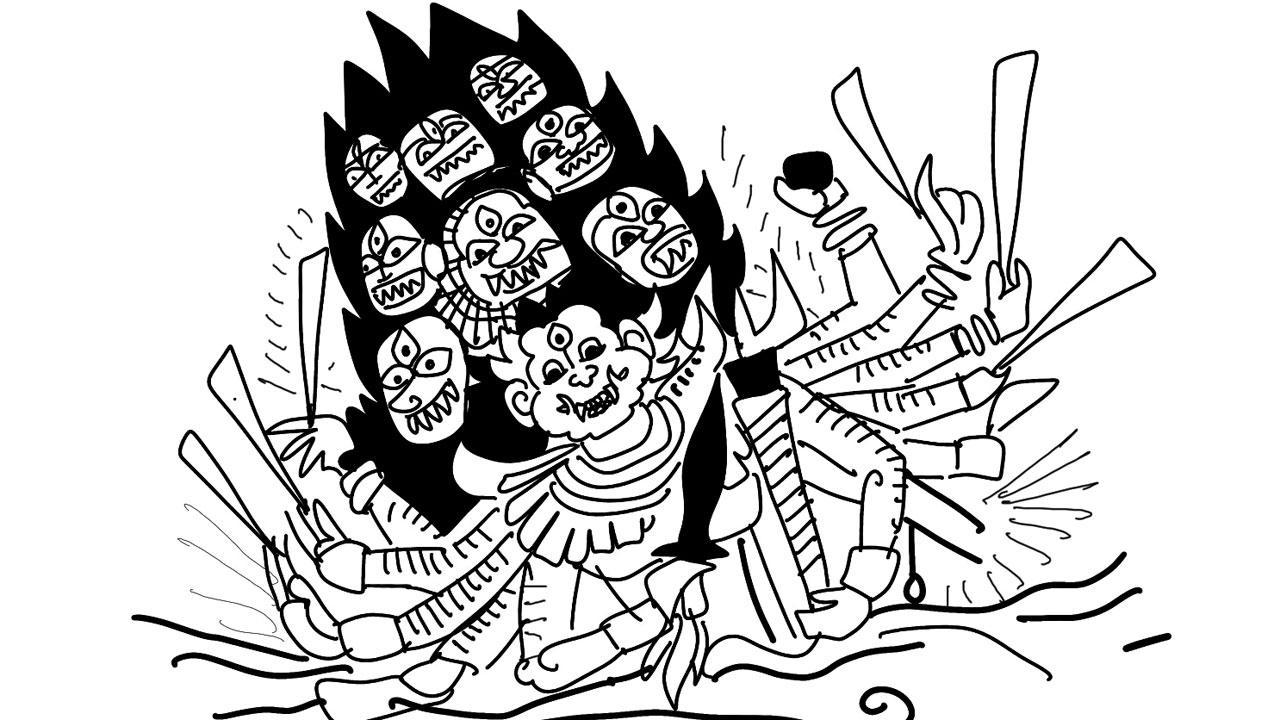This incorporation of Adam and Allah in the Ramayana is unique to the Southeast Asian narrations of the Ramayana.

Illustration/Devdutt Pattanaik
 The Ramayana has been retold by several communities and several people over a period of 2,000 years and over a region that spreads over 5,000 miles. Scholars have found the Ramayana retellings even in faraway places such as Thailand, Malaysia and Indonesia. The story was taken there by seafaring merchants.
The Ramayana has been retold by several communities and several people over a period of 2,000 years and over a region that spreads over 5,000 miles. Scholars have found the Ramayana retellings even in faraway places such as Thailand, Malaysia and Indonesia. The story was taken there by seafaring merchants.
However, in these retellings, we find many variations due to a mix of local tales. This mixture makes the reading and narration more interesting. For example, the Ramayana which is narrated in Malaysia incorporates local Islamic lore, such as concepts of Nabi (Islamic prophet) Adam . We are told that Ravana was thrown out of his house for his misbehaviour by his parents. He comes to Lanka and in Lanka, he meets Nabi Adam. In Islamic lore, after Adam is thrown out of paradise he lands in Sarandeep, the island of Sri Lanka. Thus, Sarandeep is closely associated with Adam.
Adam finds Ravana hanging upside down from a tree performing austerities. Adam asks him what he wants. Ravana answers that he wants dominion over the four worlds, the one above the sky, on earth, under the earth and in the sea. Adam says he will seek these from Allah himself, if he agrees to always follow the law. Ravana agrees and Adam secures from Allah the boons that Ravana seeks. This incorporation of Adam and Allah in the Ramayana is unique to the Southeast Asian narrations of the Ramayana.
In the Indonesian Serat Kandha, we find a few variations in the story of how Ravana was born. In one story, Ravana’s maternal grandfather, Sumali, fears the destruction of his kingdom. So, he leaves his daughter, Kaikeshi, in the care of Vaisrava Rishi. Vaisrava Rishi, although old enough to be the father of Kaikeshi, falls in love with her and forces himself on her. The first time he rapes her, she strikes his head ten times, which is why she bears a child with ten heads. The second time, she pulls his ears, and so the second child is born with long ears. The third time, she scratches him, which is why she has a daughter with long nails. The fourth time she submits, and thus the child is born normal and that is Vibhishan. This story reveals that the Indonesians were familiar with the Mahabharata, where Queen Ambika bears a blind son because she shuts her eyes when sage Vyasa comes to her. This motif is transplanted into the Indonesian version of the Ramayana.
In another story, Kubera learns of the beautiful daughter of Sumali, known as Kaikashi. He asks his father, the hermit Vaishrava, to seek her hand in marriage. Sumali agrees to the wedding proposal, provided Vaisrava teaches him and his daughter a secret magical formula. Unfortunately, when the magical formula is narrated, Shiva and Shakti are drawn to earth. Shiva enters the body of Vaisrava, Shakti enters the body of Kaikeshi and the two make love and children are born. Thus the man who had gone to fetch a daughter-in-law returned with her as his bride, to the horror of Kubera, who leaves.
These, of course, are folk versions of Indonesia. They deal with local traditions and local lore, about which we may not know. So the study of the Indonesian and Malaysian Ramayana has less to do with how Hinduism reached Southeast Asia and more to do with how they merged local beliefs, customs and history and became part of local culture.
The author writes and lectures on the relevance of mythology in modern times. Reach him at devdutt.pattanaik@mid-day.com
 Subscribe today by clicking the link and stay updated with the latest news!" Click here!
Subscribe today by clicking the link and stay updated with the latest news!" Click here!










